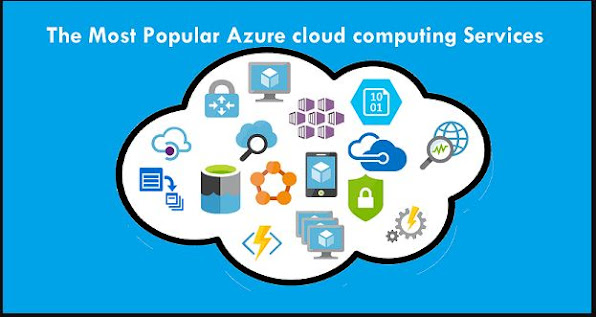- cloud computing service
- created by Microsoft
- building, testing, deploying, and managing applications and services
- through Microsoft-managed data centers
- It provides a range of cloud services, including compute, analytics, storage and networking.
- Users can pick and choose from these services to develop and scale new applications, or run existing applications in the public cloud.
- It provides,
- Software as a service (SaaS)
- Platform as a service (PaaS) and
- Infrastructure as a service (IaaS)
- Azure uses large-scale virtualization at Microsoft data centers worldwide.
- It offers more than 600 services.
- There are few main Services in Azure cloud computing.
- Computer services
- Identity
- Mobile services
- Storage services
- Communication services
- Data management
- Messaging
- Media services
- CDN
- Developer
- Management
- Azure AI
- Azure Blockchain Workbench
- Internet of Things (IoT)
- Azure Orbital
AZ-900: Microsoft Azure Fundamentals
1. Describe Cloud Concepts
· Identify the benefits of cloud computing, such as High Availability, Scalability, Elasticity, Agility, and Disaster Recovery
· Identify the differences between Capital Expenditure (CapEx) and Operational Expenditure (OpEx)
· describe the consumption-based model
· describe the shared responsibility model
· describe Infrastructure-as-a-Service (IaaS),
· describe Platform-as-a-Service (PaaS)
· describe serverless computing
· describe Software-as-a-Service (SaaS)
· Identify a service type based on a use case
· define cloud computing
· describe Public cloud · describe Private cloud · describe Hybrid cloud · compare and contrast the three types of cloud computing
2. Describe Core Azure Services
· describe the benefits and usage of Regions and Region Pairs
· describe the benefits and usage of Availability Zones
· describe the benefits and usage of Resource Groups
· describe the benefits and usage of Subscriptions
· describe the benefits and usage of Management Groups
· describe the benefits and usage of Azure Resource Manager
· explain Azure resources
· describe the benefits and usage of Virtual Machines, Azure App Services, Azure Container Instances (ACI), Azure Kubernetes Service (AKS), and Azure Virtual Desktop
· describe the benefits and usage of Virtual Networks, VPN Gateway, Virtual Network peering, and ExpressRoute
· describe the benefits and usage of Container (Blob) Storage, Disk Storage, File Storage, and storage tiers
· describe the benefits and usage of Cosmos DB, Azure SQL Database, Azure Database for MySQL, Azure Database for PostgreSQL, and SQL Managed Instance
· describe the benefits and usage of Azure Marketplace
3. Describe core solutions and management tools on Azure
· describe the benefits and usage of Internet of Things (IoT) Hub, IoT Central, and Azure Sphere
· describe the benefits and usage of Azure Synapse Analytics, HDInsight, and Azure Databricks
· describe the benefits and usage of Azure Machine Learning, Cognitive Services and Azure Bot Service
· describe the benefits and usage of serverless computing solutions that include Azure Functions and Logic Apps
· describe the benefits and usage of Azure DevOps, GitHub, GitHub Actions, and Azure DevTest Lab
· describe the functionality and usage of the Azure Portal, Azure PowerShell, Azure CLI, Cloud Shell, and Azure Mobile App
· describe the functionality and usage of Azure Advisor
· describe the functionality and usage of Azure Resource Manager (ARM) templates
· describe the functionality and usage of Azure Monitor
· describe the functionality and usage of Azure Service Health
4. Describe general security and network security features
· describe basic features of Azure Security Center, including policy compliance, security alerts, secure score, and resource hygiene
· describe the functionality and usage of Key Vault
· describe the functionality and usage of Azure Sentinel
· describe the functionality and usage of Azure Dedicated Hosts
· describe the concept of defense in depth
· describe the functionality and usage of Network Security Groups (NSG)
· describe the functionality and usage of Azure Firewall
· describe the functionality and usage of Azure DDoS protection
5. Describe identity, governance, privacy, and compliance features
· explain the difference between authentication and authorization
· define Azure Active Directory
· describe the functionality and usage of Azure Active Directory
· describe the functionality and usage of Conditional Access, Multi-Factor Authentication (MFA), and Single Sign-On (SSO)
· describe the functionality and usage of Role-Based Access Control (RBAC)
· describe the functionality and usage of resource locks
· describe the functionality and usage of tags
· describe the functionality and usage of Azure Policy
· describe the functionality and usage of Azure Blueprints
· describe the Cloud Adoption Framework for Azure
· describe the Microsoft core tenets of Security, Privacy, and Compliance
· describe the purpose of the Microsoft Privacy Statement, Online Services Terms (OST) and Data Protection Amendment (DPA)
· describe the purpose of the Trust Center
· describe the purpose of the Azure compliance documentation
· describe the purpose of Azure Sovereign Regions (Azure Government cloud services and Azure China cloud services)
6. Describe Azure cost management and Service Level Agreements
· identify factors that can affect costs (resource types, services, locations, ingress and egress traffic)
· identify factors that can reduce costs (reserved instances, reserved capacity, hybrid use benefit, spot pricing)
· describe the functionality and usage of the Pricing calculator and the Total Cost of Ownership (TCO) calculator
· describe the functionality and usage of Azure Cost Management
· describe the purpose of an Azure Service Level Agreement (SLA)
· identify actions that can impact an SLA (i.e. Availability Zones)
· describe the service lifecycle in Azure (Public Preview and General Availability
✍️ -Prabath Bandara-











No comments:
Post a Comment